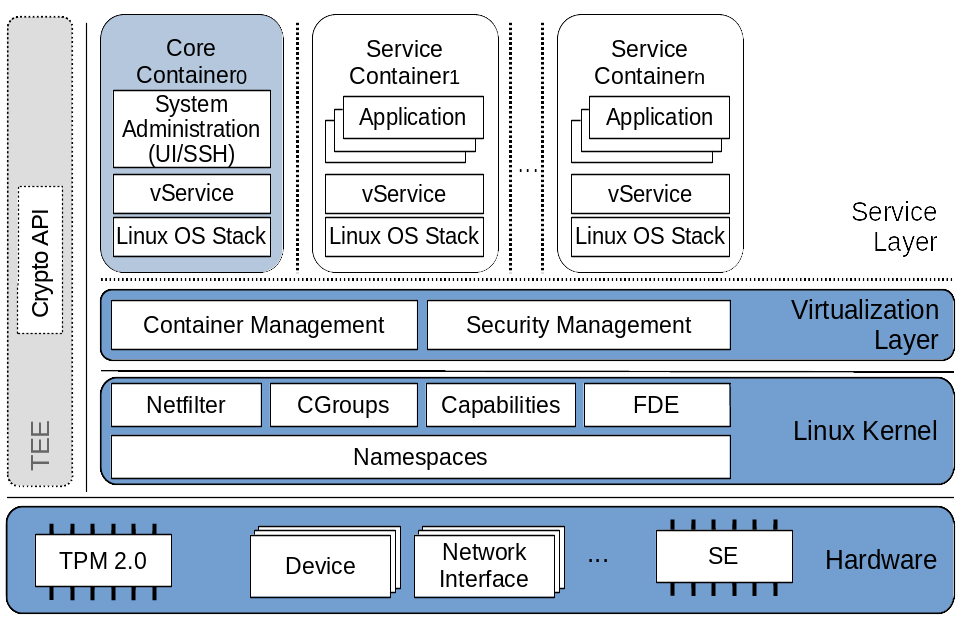What is GyroidOS
GyroidOS (/dʒaɪrɔɪd/) is a multi-arch OS-level virtualization solution with additional focus on platform security based on hardware features. It aims to support certification processes according to certain industry standards, see certification. The core component, the virtualization layer, is based on Linux-specific features like namespaces, cgroups and capabilities to provide isolation of different Guest Operating System (GuestOS) stacks on top of a single, shared Linux kernel. In contrast to other container solutions like Docker, GyroidOS provides a small software stack footprint and additional separation of privileged instances. The illustration below shows the system architecture of GyroidOS.

User interaction (e.g. admin access through ssh) may not directly end up in the privileged root namespace. For that purpose a less privileged core container exists, which is already namespaced and may interact with the privileged virtualization layer through a single specified interface only. This can be compared to the dom0 approach of Xen.
Furthermore, special platform security features are directly integrated into the virtualizaion layer in form of services utilizing a TPM chip and other platform dependent hardware-based security mechanisms. In a nutshell, GyroidOS offers the following security features and benefits:
Security features
- Solid container isolation based on modularized OS-level virtualization layer
- Secure boot (e.g. using UEFI on x86)
- Kernel module signing
- Signed GuestOSes (containers)
- Measured boot and remote attestation
- Full disk encryption coupled to TPM and secure boot
- Restriction of superuser in containers with Linux capabilities
- Fine-grained device access with device cgroups whitelists
- Secure Element support for two-factor authentication, e.g., when starting containers
- (upcoming) Relocation of cryptographic keys and ciphers into TEEs (e.g., Kernel Crypto API)
Benefits
- Maintained, fully open source software stack
- Straightforward build and run of custom containers
- Easy portability to different embedded platforms
- Converter functionality for Docker containers (experimental)
- Flexible remote management via core container (e.g., container deployment, updates, …)
- PKI support for software signing and device identity
Getting started
To get started, first set up the build environment. After that, you can build the GyroidOS base system, i.e., kernel, virtualization layer and the core container. There is also a quickbuild option and a tutorial how to create your custom GuestOSs. Once GyroidOS is built, you might want to test it on QEMU/KVM before deploying it onto your target platform (see Deploy options). We provide an overview on how to manage and configure a deployed GyroidOS system. We also provide descriptions on how to securely roll-out a platform running GyroidOS using our proposed PKI.
The remainder of this page highlights possible use cases, supported platforms and related scientific publications. For more information on GyroidOS and OS-Level virtualization, read our background page.
Use cases
- Application separation. Similar to Docker GyroidOS can be used to separate applications in server environments, yet providing a full system inside a container closer to type 1 hypervisors such as Xen.
- IoT edge devices. Its stripped-down version – just a kernel and a small ramdisk as virtualization layer – targets embedded systems which can be used in the IoT context for edge devices. GyroidOS also provides the reference implementation for the so-called Trusted Connector in the International Data Space. The International Data Spaces provides concepts for a generic, shared data cloud for the (industrial) Internet of Things
Supported platforms
The GyroidOS software stack runs on following hardware platforms:
| Architecture | Device | Secure boot implementation |
|---|---|---|
| x86 32/64 | Native Intel PC | UEFI Secure Boot |
| x86 32/64 | Qemu | TianoCore (simulated UEFI secure boot and sTPM) |
| ARM 64 | Raspberry Pi4 and 5 | RPi Secure Boot |
| ARM 64 | Raspberry Pi3 | Uboot Verified Boot |
| ARM 32 | Raspberry Pi2 | Uboot Verified Boot |
| ARM 64 | TQ-Systems TQMa8MPxL | Uboot Verified Boot |
| RISC-V 64 | BeagleV-Fire | Uboot Verified Boot |
Publications
| Year | Title | Authors | |
|---|---|---|---|
| 2024 | HETCOM: Heterogeneous Container Migration Based on TEE- or TPM-established Trust | Felix Wruck, Maximilian Peisl, Christian Epple, Michael Weiß | https://doi.org/10.1145/3643650.3658610 |
| 2022 | GyroidOS: Packaging Linux with a Minimal Surface | Felix Wruck, Vasil Sarafov, Florian Jakobsmeier, Michael Weiß | https://doi.org/10.1145/3510547.3517917 |
| 2018 | An Ecosystem and IoT Device Architecture for Building Trust in the Industrial Data Space | Gerd Brost, Manuel Huber, Michael Weiß, Mykolai Protsenko, Julian Schütte, Sascha Wessel | https://doi.org/10.1145/3198458.3198459 |
| 2017 | Freeze & Crypt: Linux Kernel Support for Main Memory Encryption | Manuel Huber, Julian Horsch, Junaid Ali, Sascha Wessel, | http://dx.doi.org/10.5220/0006378400170030 |
| 2015 | A Secure Architecture for Operating System-Level Virtualization on Mobile Devices | Manuel Huber, Julian Horsch, Michael Velten, Michael Weiß, Sascha Wessel | http://dx.doi.org/10.1007/978-3-319-38898-4_25 |
| 2015 | Improving mobile device security with operating system-level virtualization (Journal) | Sascha Wessel, Manuel Huber, Frederic Stumpf, Claudia Eckert | https://doi.org/10.1016/j.cose.2015.02.005 |
| 2013 | Improving Mobile Device Security with Operating System-Level Virtualization | Sascha Wessel, Frederic Stumpf, Ilja Herd, Claudia Eckert | https://doi.org/10.1007/978-3-642-39218-4_12 |
